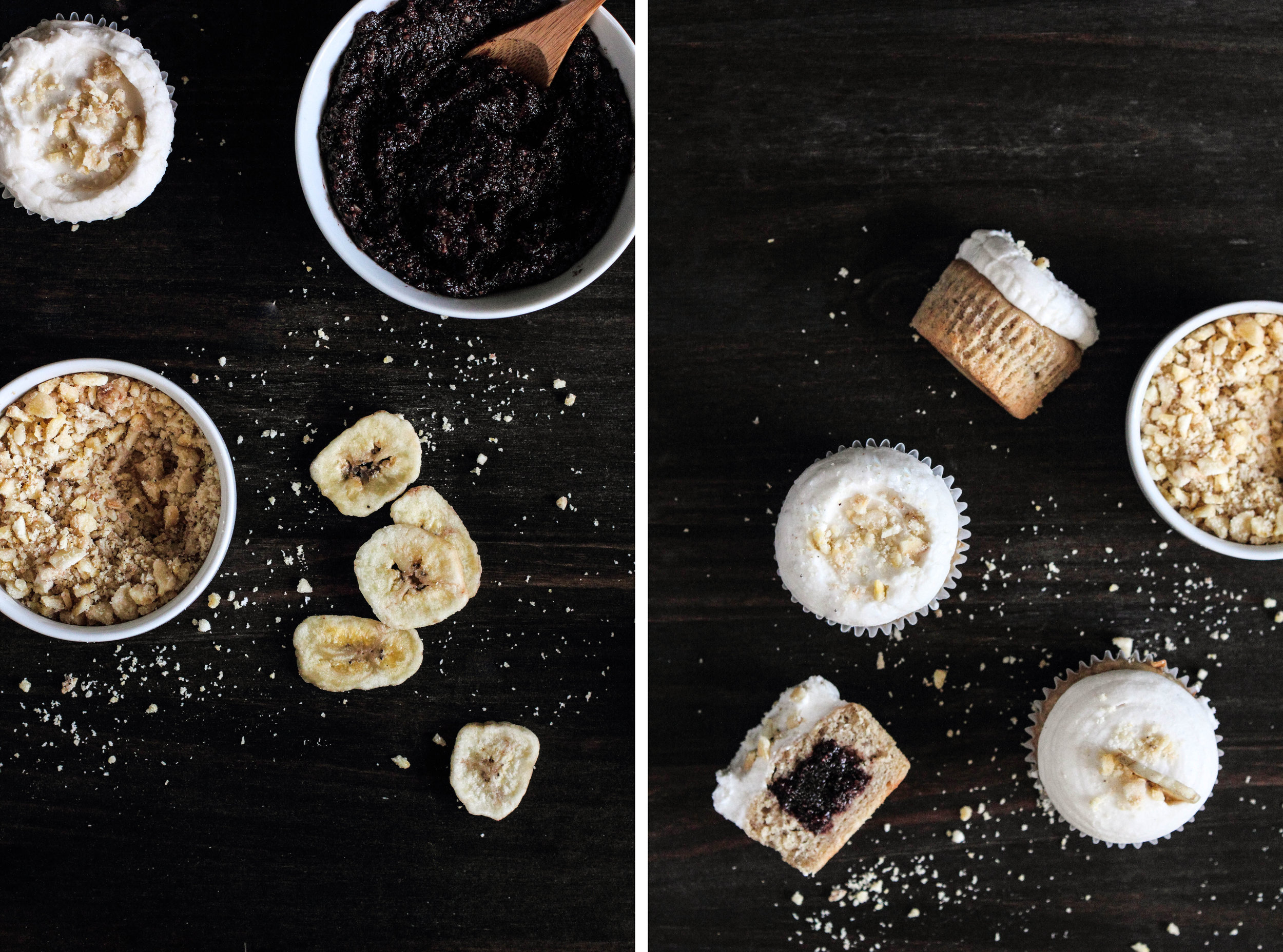Banana Chocolate Hazelnut Cupcakes
/There are a dozen or so recipes that are regarded as family recipes in my home, passed down from earlier generations. Among those held most dear are our honey cookies, which grace the dessert table when the holidays arrive, and my Grandmother Irene's orange rolls, which are made when the snow melts and stand for the hallmark beginning of spring. As I've grown older, I've quietly added a few of my mother's recipes to this coveted list, the recipes that I remember most from childhood.
And that is what brings me to this banana cake.
My mother originally found her recipe in an old church cookbook. Written by a friend of my grandmother, the cake had just six ingredients—sugar, sour cream, eggs, flour, baking soda, and bananas. My mother played around with the basic recipe, adding an unavoidable chocolate glaze (or chocolate chips in a pinch). Eventually shortening was added to give the cake a source of fat, which produced less of a bread-like texture and more like the feel of a cake.
After I took hold of the recipe, I couldn't help myself from giving it my own twist and took it through a few more iterations before reaching this point. The spirit of the original, however, is just the same.
The cake is made with shortening, which may be an unusual choice in the age of "butter is best," but I can assure you that it is the right choice. Shortening gives the cake a bit of heft, the feel of a peanut butter sandwich against the roof of your mouth, without weighing the cake down. Butter is just not capable of this texture in the same situation. The addition of sour cream and buttermilk ensure the cake has a tender crumb. It is the banana cake I remember, in its purest form.
As you know by now, I can never leave anything alone for long. I filled the cupcakes with homemade chocolate hazelnut spread (though the brand name alternative would also suit). For the pièce de résistance, the cupcake is topped with a banana buttercream. A fresh banana is beat into the frosting with a little lemon juice to prevent browning. The subsequent flavor is so true and vibrant I wondered why I haven't been doing this from the beginning.
Banana Chocolate Hazelnut Cupcakes is one of the evolutions of my mother's banana cake. The cake itself is rich in crumb and flavor, but the sweetness does not overwhelm. Filled with chocolate hazelnut spread, the chocolate complements, but does not overpower the subtle flavor of the banana. Topped with a banana buttercream, the banana flavor is confirmed once more, providing a light texture contrast to the cake.
One Year Ago: Coconut Macaroons and Honey Almond Quinoa Granola
Two Years Ago: Coconut Whipped Cream, Chocolate Candied Ginger Biscotti, Banana Cinnamon Pancakes, and Raspberry Cream Cheese Lemon Cupcakes
Three Years Ago: Chocolate Toffee Scones, Rosemary Sea Salt Crackers, Grapefruit Cake, and Chocolate Caramel Crispy Bars
Four Years Ago: Coconut Cream Cupcakes, Yeasted Waffles, Italian Breadstick Popcorn, and Peanut Butter Chocolate Chip Cookies
Banana Cupcakes with Chocolate Hazelnut Filling and Banana Frosting
Yields 2 dozen cupcakes
Banana Cupcakes with Chocolate Hazelnut Filling
1/2 cup (100 grams) shortening, room temperature
1/2 cup (100 grams) white sugar
3/4 cup (150 grams) brown sugar
2 large eggs
3 medium to large overripe bananas, mashed
1/2 cup (115 grams) sour cream
1 teaspoon vanilla extract
2 1/2 cups (315 grams) all-purpose flour
2 teaspoons baking powder
1/2 teaspoon ground cinnamon
1/2 teaspoon salt
1/2 cup (120 ml) buttermilk
1 cup (280 grams) chocolate hazelnut spread
Preheat oven to 350 degrees F (180 degrees C). Line cupcake pan with liners.
In a medium bowl, whisk together flour, baking powder, cinnamon, and salt. Set aside.
In a large mixing bowl, cream together the shortening and sugars until light and fluffy. Add the eggs one at a time, beating well after each addition. Mix in the mashed bananas, sour cream, and vanilla extract.
Alternatively add and beat in the flour mixture and buttermilk in 3 additions, starting and ending with the flour. Fill baking liners 3/4 full with batter. Bake for 20-30 minutes, or until golden and a toothpick inserted in the center comes out clean. Cool completely before filling and frosting.
To fill, use a sharp knife (or cupcake corer) to cut out a small cavity in the center of the cupcake. I run the knife in a circular motion, while always pointing the knife towards the center of the cupcake. Aim for the cavity to be cone shaped. Using a pastry bag filled with chocolate hazelnut spread, fill the cupcake with the spread until nearly to the top. Cut the top off the cupcake piece you removed and press it back on the cupcake to seal the filling.
Banana Frosting
1 large ripe banana, mashed (about 1/2 cup)*
1 teaspoon lemon juice
1/2 cup (113 grams) butter, room temperature
1 teaspoon vanilla extract
1/2 teaspoon salt
3 1/4 to 4 cups (400-500 grams) powdered sugar
Banana chips (for garnish)
In a small bowl, mash the banana with the lemon juice until very smooth. Set aside.
In a large mixing bowl, beat butter until smooth. Add the mashed banana, vanilla, and salt and continue beating until uniform. Gradually add the powdered sugar, stopping once a spreadable texture has been reached. Fill a pastry bag and pipe or spread frosting on the cupcakes. Garnish with a banana chip and crushed banana chip pieces.
* The banana should be ripe enough to eat, but contain no brown spots (it will stain the buttercream). If you do encounter a brown spot, cut it fully out of the banana before mashing.























